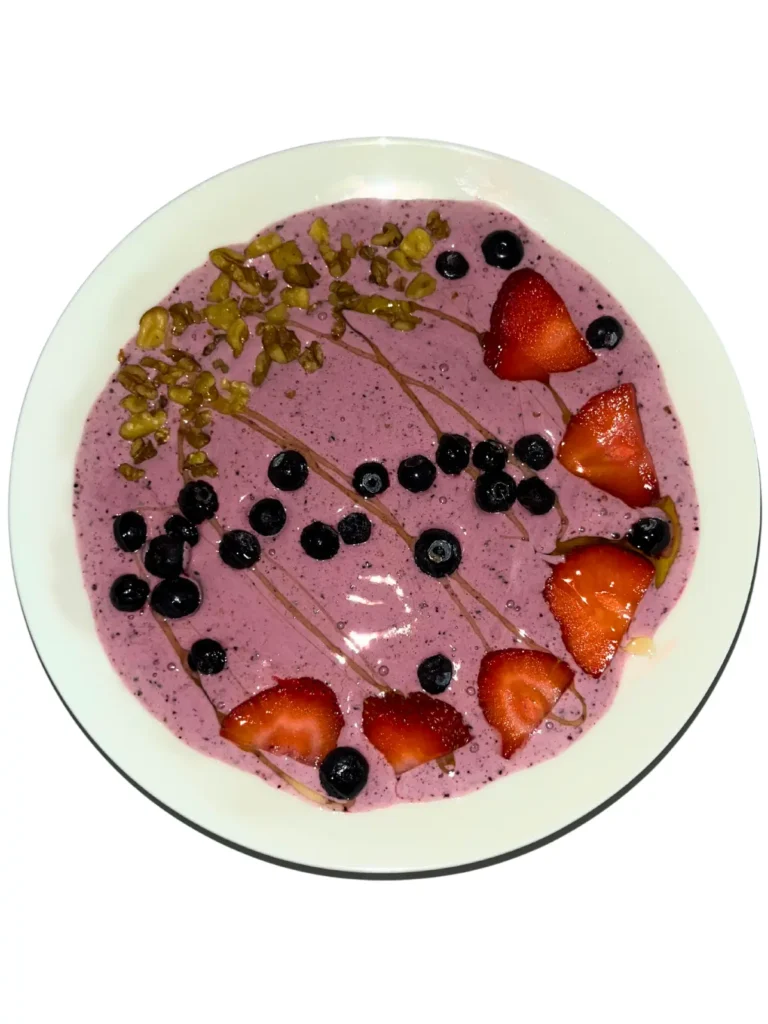Consuming high volume, low calorie meals can be an effective strategy for weight loss and maintenance. Research studies have shown that consuming a large volume of low-density foods, such as soup, salad or fruit can enhance the feeling of fullness and lead to overall decreased energy intake (1).

If you’ve been trying to restrict calories but find that you’re just not satisfied after each meal – trying adding more instead of restricting. By selecting foods that are lower in energy density, a meal can appear much larger while still being low in calories. This strategy assists with increased satisfaction after a meal.
Maybe you are someone who has difficulty restricting portion sizes. With energy dense meals, this is not something you have to worry about.
For example – my husband is used to seeing a large volume of food on his plate. Otherwise, he doesn’t feel like it’s “filling” enough – despite how many calories he’s consuming. Therefore, the visual appearance of a meal that looks large in volume but is essentially mostly vegetables may be an effective way to reduce overall caloric intake.
In this post, we will discuss how high volume, low calorie meals can be an effective weight management strategy as well as example meals ideas.

Energy Density of Food
The energy density of food is the amount of energy in a particular weight of food (calories per gram). It is entirely dependent on the food’s macronutrient content.
Carbohydrates and protein both provide 4 calories per gram. Fat is higher in energy density, as it provides 9 calories per gram. Foods that are high in fat can be double the amount of calories as one that is high in carbohydrates or protein. For example, one tablespoon of butter contains double the amount of calories of one CUP of strawberries.
In general, foods that are considered low in energy-density have a 1) high water content, 2) contain a lot of fiber, 3) have very little fat. A low energy density food translates to lower calories in a large quantity. Studies have shown that consuming foods with lower energy density – such as fruits, vegetables, whole grains, lean protein, and low-fat dairy products – helps people lower their caloric intake (2).

Building Blocks of Low Calorie, High Volume Meals
Fruits and Vegetables
Fruits and vegetables are a food group, and not a macronutrient. They are, however, the foundation of these meals.
Foods which are high in water contribute weight and volume without the additional calories. Vegetables consist of mostly water, therefore, you can consume a large quantity with very little calories.
Fruit is another energy-dense food, however, often higher in calories than vegetables.
Fiber is an important nutrient in that it assists with helping us feel full for a longer period of time. Therefore, fruits and vegetables are essential in a high volume, low calorie meal.
If you’re worried about the expense of buying fruits or vegetables – frozen can be just as healthy as fresh.
Protein
Protein is the macronutrient which takes the longest to digest, therefore, it is important to include a protein source for satiation. If your goal is weight loss, ensuring adequate protein intake can help to preserve lean body mass while calories are restricted.
When choosing protein sources for a high volume, low calorie meal it is important to pick a lower fat option and be mindful of the serving size. For example, a typical portion of meat is 4 ounces (or the size of your palm). The larger the portion, the more calories you will add to your meal.
For more in-depth information regarding protein and its’ role in our body, read my post The Importance of Protein in the Body.
Carbohydrates
Sure, you can opt out of foods high in carbs at some meals – but restricting entire food groups from your diet is usually not sustainable in the long-run. Carbohydrates provide our bodies with its’ main source of fuel. A diet low in carbs can really affect your physical and mental health, and limit your intake of essential vitamins and minerals.
Selecting whole grains and complex carbohydrates versus refined carbs help to improve satisfaction and that feeling of fullness after a meal. Complex carbs are packed with nutrients and release glucose into our bloodstream at a slower rate – helping us stay full for a longer period of time.
So what are some examples of complex carbohydrates? Whole grains, fiber-rich fruits and vegetables, and beans.
Fats
A small amount of fat is an essential part of a healthy, balanced diet. Fat, however, provides the highest energy density of all three macronutrients.
By prioritizing fruits, vegetables, whole grains, and lean protein as well as being mindful of additions like olive oil and butter, we can better control the caloric intake of these meals.
Putting Together a High Volume, Low Calorie Meal

When putting together a high volume, low calorie meal – there are a few things you should consider.
1) What exactly is “low calorie”? This is such a variable answer. The whole concept of high volume, low calorie meals is to consume a larger quantity of food for less calories. Counting calories, however, is not necessary. Our overall caloric intake will reduce just by applying these principles.
2) Fruits and vegetables are the foundation of these meals. For lunch and dinner, you are essentially adding more vegetables to these meals to make them appear higher in volume.
3) Vegetables with a higher energy-density include russet potatoes, corn, peas, parsnips, avocado, butternut squash and sweet potatoes. Of course, they should be included in a well-balanced diet – just be aware.
4) Ensure there is at least one serving of a lean protein with all meals.
5) Make sure to include a serving size of whole grain or complex carbohydrates at two meals per day.
6) Try to select low sodium seasonings or lighter dressings/sauces to add flavor to the dish. Another technique I use frequently is add chicken broth to about 2 Tbsp. of a higher calorie sauce to thin it down without sacrificing taste and ensuring adequate moisture for certain dishes.
High Volume, Low Calorie Meal Ideas
1. Spaghetti Squash
Feeling like pasta without all of the refined carbohydrates and calories? Spaghetti squash, when cooked correctly, can closely resemble the perfect al dente pasta. Packed with nutrients and only 40 calories per cup, you can essentially eat a huge bowl of it while it still being low in calories.
It can be as simple as cooking some chicken, and adding your favorite pasta sauce with a little parmesan cheese – to elevating it with a cream sauce. There are so many variations out there on the internet.
Recipes to try:
- Forget About Pasta: 28 Delicious Spaghetti Squash Recipes
- Chicken Alfredo Spaghetti Squash
- Creamy Garlic Spaghetti Squash
2. A Large Salad

A big salad is the quintessential high volume, low calorie meal. Packed with low-calorie lettuce, a vast array of different vegetables, and lean-protein sources like grilled chicken or garbanzo beans.
Add some nutrient-dense seeds for healthy fats, with a light vinaigrette dressing. This combination promotes a sense of fullness, but also keeps you energized and supports weight management.
Recipes to try:
- Nutrient-Packed, Filling Salad Guide {with Recipes}
- BBQ Ranch Chopped Chicken Salad by Chew Out Loud
- 15 High Protein, Low Calorie Salads by Eating Well
3. Stir-Fry

A stir-fry is another perfect idea for high-volume meals in that you can add as many vegetables are you want. It can be served with brown rice, quinoa, or rice noodles. Just be sure to include a large quantity of vegetables, and go light on the sauce. Hot sauce and sriracha are low calorie sauces which could work with a stir-fry!
Recipes to try:
- Ground Chicken Stir Fry with Veggies by Sprinkled with Balance
- Pork and Cabbage Stir Fry by Deb’s Daily Dish
- Honey Garlic Stir Fry by Dinner at the Zoo
4. Cauliflower Rice Bowl
Replace regular rice with cauliflower rice for a low calorie base to a delicious power bowl. Build your bowl with roasted veggies and a lean protein, as well as a flavorful sauce.
Recipes to try:
- Cauliflower Rice Burrito Bowl by Minimalist Baker
- Mediterranean Grain Bowl, sub the quinoa for cauliflower rice
5. Omelet with Veggies

Use a combination of eggs and egg whites for a high protein breakfast (or dinner), with the addition of asparagus, spinach, mushrooms, and a sprinkle of shredded cheese.
You could add some cooked quinoa or serve it with some whole-grain toast for increased satiety.
6. Greek Yogurt Parfait
A serving of Greek yogurt is both high in protein and low in calories. Add fresh berries, and some granola for a well-balanced breakfast or snack. Sprinkle with hemp hearts for additional protein and nutrients.
Recipes to try:
- Greek Yogurt Parfait by Seasoned to Taste
- Yogurt Parfait by Simply Homecooked
7. Stuffed Bell Peppers or Lettuce Wraps

Hollowed out bell-peppers can be the perfect vessel for a well-balanced but high volume meal. Stuff each pepper with quinoa or brown rice, and lean beef. Add some additional vegetables to the filling to make each pepper lower in calories, so you could consume 2-3 of them at one meal.
Recipes to try:
- Ground Chicken Stuffed Peppers by One Wholesome Life
- Yuk Sang Lettuce Wraps by The Cinnamon Jar
8. Broth-Based Soup

Ever wanted more than one bowl of soup? A soup loaded with veggies, legumes, and lean meat is a great idea for just that.
Recipes to try:
- Chicken Tortilla Soup by Beyond Mere Sustenance
- Stuffed Pepper Soup by Dinner at the Zoo
- Slow Cooker Cabbage Roll Soup by The Short Order Cook
9. Nut Butter Oatmeal
Adding nut butter (like peanut butter) to your oatmeal will improve satisfaction with the addition of protein. Top it with a variety of fruits to for added fiber and volume. Elevate it even more with healthy fats like chia or flaxseeds.
10. Smoothie Bowl
Smoothie bowls are the ideal high volume, low calorie breakfast – because they take a long time to eat! For example, this High Protein Lemon Berry Smoothie Bowl packs a nutritional punch but it’s a very large serving and only 400 calories! Easily customize with your favorite flavors and toppings.

In Conclusion: Add More, Restrict Less!
So there you are! High volume, low calorie meals – the idea of focusing more on what you can add to your meals instead of what you can restrict.
It’s less about actually counting calories, as trying this strategy will essentially decrease your overall caloric intake while ensuring you are satisfied after every meal!
There are so many benefits, including weight management, increased energy, and improved nutrient intake. Use these tools as a lifestyle change to better you and your health!
Let me know in the comments what part of this post was helpful to you!
